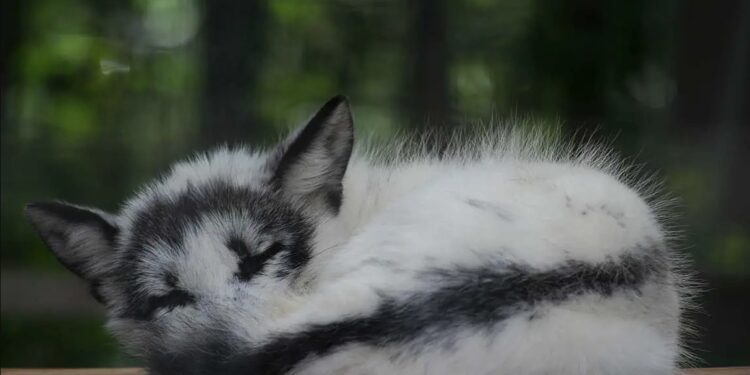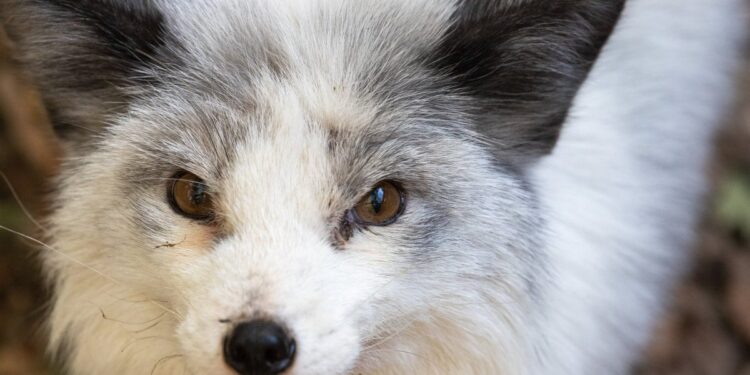The Canadian Marble Fox is a mesmerizing creature that has captured the imagination of wildlife enthusiasts and researchers alike. With its striking appearance and intriguing behavior, this elusive species stands out as a symbol of nature’s exquisite artistry. In this article, we will delve into the depths of the Canadian Marble Fox’s world, exploring its physical characteristics, unique adaptations, and conservation efforts aimed at preserving its enigmatic majesty.
Understanding the Canadian Marble Fox

Overview of the Canadian Marble Fox
The Canadian Marble Fox, scientifically known as Vulpes vulpes, is a captivating member of the Canidae family. With a mix of colors, including shades of white, black, and grey, their fur creates a stunning marble-like pattern that sets them apart from other fox species. As a subspecies of the red fox, they share similarities but also possess distinct traits that make them truly extraordinary.
Physical Appearance and Characteristics
The Canadian Marble Fox boasts a medium-sized body with a sleek and elegant build. They have distinct features such as their bushy tail, which serves various purposes, including balance and warmth during cold winters. Their keen eyes and an acute sense of smell aid them in navigating their environment with precision.
Hight
The Canadian Marble Fox typically has an average height of around 35-50 centimeters (14-20 inches) at the shoulder. However, it’s important to note that individual heights may vary slightly depending on factors such as age, sex, and overall health. These foxes possess a sleek and elegant build, with their height contributing to their agility and ability to navigate their natural habitat with precision.
Weight
The weight of a Canadian Marble Fox typically falls within the range of 3.5 to 6 kilograms (7.7 to 13.2 pounds). However, it’s important to note that individual weights may vary depending on factors such as age, sex, and overall health. These foxes have medium-sized bodies, and their weight contributes to their ability to navigate their environment, hunt prey, and withstand the challenges of their northern habitat.
Distribution and Habitat
Endemic to the northern regions of North America, the Canadian Marble Fox primarily inhabits the remote areas of Canada, especially in provinces like British Columbia, Yukon, and Northwest Territories. They prefer a habitat with a mix of dense forests and open tundra, where they can find ample prey and suitable shelter.
The Fascinating Adaptations of the Canadian Marble Fox
Unique Camouflage Abilities
One of the most remarkable features of the Canadian Marble Fox is its exceptional camouflage abilities. The intricate mix of white and dark fur allows them to blend seamlessly into their surroundings, providing excellent cover while hunting or evading predators. This natural camouflage is a testament to the species’ evolutionary prowess.
Agile Hunting Skills
The Canadian Marble Fox is a highly skilled predator, relying on its agility and intelligence to secure prey. With sharp reflexes and the ability to make quick decisions, they can successfully catch small rodents, birds, and even larger prey like rabbits. Their hunting techniques have been observed to include stealthy approaches and precise leaps to capture their targets.
Survival Tactics in Harsh Environments
The northern regions of Canada, where the Canadian Marble Fox thrives, are known for their harsh and unforgiving climates. To survive the extreme cold and scarcity of food during winter, these foxes exhibit remarkable resilience. They store excess food, grow thicker fur, and seek shelter in burrows or dens to endure the frigid temperatures.
Life Cycle and Behavior of Canadian Marble Foxes
Reproduction and Mating Habits
The Canadian Marble Fox follows a seasonal breeding pattern, with mating occurring during the winter months. During this time, male foxes engage in elaborate displays and vocalizations to attract females. Once a pair bonds, they remain monogamous throughout the breeding season.
Parental Care and Nurturing
After a successful mating, the female constructs a secure den to protect her offspring. The gestation period lasts for about 50-60 days, after which a litter of 3-6 adorable fox kits is born. Both parents play a crucial role in nurturing and protecting the young ones until they are old enough to venture out on their own.
Social Structure and Communication
Canadian Marble Foxes are solitary animals, except during the breeding season and when raising their young. They utilize various vocalizations, body postures, and scent markings to communicate with one another and establish territories. These complex communication methods ensure effective social interactions among individuals.
Diet and Feeding Habits of Canadian Marble Foxes
Natural Prey and Hunting Techniques
The Canadian Marble Fox is an opportunistic carnivore, with a diverse diet that includes small mammals, birds, fish, and insects. Their hunting techniques are a blend of patience, stealth, and swift attacks. They are known to stalk their prey and utilize their keen senses to locate and pounce on unsuspecting targets.
Opportunistic Foraging
In addition to hunting, Canadian Marble Foxes are skilled scavengers, making the most of available food sources. They are known to scavenge on carrion left behind by larger predators or feast on the remnants of other animals’ kills. This adaptability ensures their survival in challenging environments.
Impact on Local Ecosystems
As predators, Canadian Marble Foxes play a vital role in maintaining the balance of local ecosystems. By regulating populations of small mammals and controlling pest species, they contribute to the health and stability of their habitat. Their presence is an essential component of the intricate web of life in the regions they inhabit.
Conservation Status and Threats to Canadian Marble Foxes
Historical Decline and Current Population Status
The Canadian Marble Fox has faced significant challenges over the years, resulting in a decline in population numbers. Factors such as habitat loss, climate change, and human activities have impacted their survival. Currently, the species is listed as of special concern by conservation organizations, emphasizing the need for protective measures.
Habitat Loss and Fragmentation
One of the primary threats to Canadian Marble Foxes is the loss and fragmentation of their natural habitat. Human encroachment, industrial development, and deforestation have reduced the available space for these foxes to thrive. This loss of suitable habitat disrupts their feeding and breeding patterns, leading to population decline.
Human Interactions and Hunting
Unfortunately, human interactions have also posed significant challenges to the survival of Canadian Marble Foxes. Illegal hunting, trapping, and the fur trade have had detrimental effects on their populations. Raising awareness about the importance of preserving these foxes and enforcing stricter regulations are crucial steps toward their conservation.
Efforts in Protecting the Canadian Marble Fox
Conservation Initiatives and Organizations
Numerous conservation initiatives and organizations have dedicated their efforts to protecting the Canadian Marble Fox and its habitat. Through research, habitat restoration, and educational campaigns, these organizations strive to raise awareness and implement measures that safeguard the species for future generations.
Legislative Measures and Wildlife Protection
Legislation plays a crucial role in protecting the Canadian Marble Fox. Governments at local, provincial, and federal levels have implemented wildlife protection acts and regulations that prohibit hunting and trapping of these foxes. Such legal frameworks provide a foundation for conservation efforts and reinforce the importance of preserving their populations.
Research and Monitoring Programs
To better understand the Canadian Marble Fox and address conservation challenges, ongoing research and monitoring programs are essential. Through these initiatives, scientists gather data on population trends, habitat use, and ecological interactions. This knowledge informs conservation strategies and aids in making informed decisions for the species’ well-being.
Read Also: Exploring the Micro Bully: A Compact and Adorable Canine Companion
Ecotourism and the Canadian Marble Fox

The Allure of Wildlife Encounters
The Canadian Marble Fox and its captivating presence have drawn the interest of wildlife enthusiasts and tourists. Ecotourism initiatives have emerged, providing opportunities for individuals to observe these foxes in their natural habitats. Responsible ecotourism allows visitors to appreciate the beauty of the species while contributing to its conservation.
Responsible Ecotourism Practices
Responsible ecotourism practices ensure that encounters with Canadian Marble Foxes are conducted ethically and sustainably. Strict guidelines, including minimal disturbance, maintaining safe distances, and respecting the animals’ behavior, protect the foxes and their habitat from any potential harm. These practices promote harmonious coexistence between humans and wildlife.
Benefits to Local Communities and Conservation Efforts
Well-managed ecotourism activities have the potential to bring significant benefits to local communities and conservation efforts. By providing alternative sources of income, promoting cultural appreciation, and supporting conservation initiatives, ecotourism can create a positive ripple effect, fostering local pride and a sense of stewardship for the Canadian Marble Fox.
The Symbolic Significance of the Canadian Marble Fox
Cultural and Indigenous Representations
The Canadian Marble Fox holds symbolic significance in various cultural and indigenous traditions. Through myths, stories, and artwork, it embodies traits such as wisdom, adaptability, and resilience. Recognizing and honoring these representations further highlights the importance of protecting the species and its natural habitat.
Conservation as a Symbol of National Identity
The conservation of the Canadian Marble Fox goes beyond its ecological significance; it represents a broader commitment to preserving Canada’s natural heritage. By prioritizing the protection of this iconic species, the nation affirms its dedication to environmental stewardship and its responsibility to future generations.
Inspiring Stewardship and Conservation Action
The allure of the Canadian Marble Fox and its conservation challenges inspire individuals to take action. By fostering a sense of stewardship and personal responsibility, people are encouraged to support conservation organizations, practice sustainable behaviors, and advocate for policies that prioritize wildlife preservation. Together, these efforts contribute to the long-term survival of the Canadian Marble Fox.
Conclusion
The Canadian Marble Fox is a captivating creature that embodies nature’s artistic prowess. Its unique physical appearance, remarkable adaptations, and intrinsic value as a part of the ecosystem make its preservation imperative. By understanding the challenges they face, promoting conservation initiatives, and embracing responsible practices, we can ensure that the enigmatic majesty of the Canadian Marble Fox endures for generations to come.




